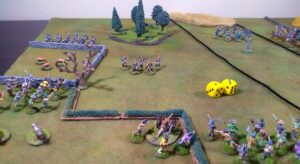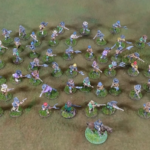I’ve only got a couple of fights under my belt, so it may be too early to tell, but it hasn’t really grabbed me.
This is another sibling in the Rampant Family of Rules, and unlike its older brethren, a tabletop general get one attempt to activate each unit under his command. In most Rampant games the player must prioritize his activations, as the first failure (barring special abilities or mandatory activations) ends his turn. This is perfectly in keeping with upgrades in command and control during this era.
One might expect this to speed play along, as more units are moving each turn. Counter-intuitively, it slows the game down as players no longer have to prioritize one side of the battle, or shift focus when some recalcitrant units refuse to act according to plan. The loss of that risk-reward decision point means that play doesn’t bounce back and forth in Rebels and Patriots the way it does in other titles in the series.
 Being a black-powder game, the unit profiles have been stream-lined somewhat with the range of courage reduced to a simple plus or minus to courage scores. A greater emphasis is placed on the challenges of determining when to button up units into close-order, and when to break formation, and when to trade hot lead fired in a ragged line for the hot charge in with the cold steel of the bayonet.
Being a black-powder game, the unit profiles have been stream-lined somewhat with the range of courage reduced to a simple plus or minus to courage scores. A greater emphasis is placed on the challenges of determining when to button up units into close-order, and when to break formation, and when to trade hot lead fired in a ragged line for the hot charge in with the cold steel of the bayonet.
Then there is the expansion of unit status from “battered -> routed” to “disordered -> broken -> routed” and the addition of special events when activation rolls come up snake-eyes or boxcars, and you’ve got a lot more if-then statements than seen in previous iterations of the rules. All of this added complexity helps to provide the flavor and feel of the line-’em-up phase of black-powder warfare, but it makes the game drag beyond its welcome.
It’s times like these I long for a meatspace opponent that could help me remember all the little exceptions and counter-exceptions.
I’m likely to shift back to Fistful of Lead: Bigger Battles, which places more of the workload on unit design, if only because the resulting tabletop fight flows much smoother. That said, even if this book goes up on the shelf, it will stay close at hand if only due to the scenarios. It includes an even dozen scenarios, and each of them adds even more complexity to the game – a complexity that a game like Bigger Battles can accommodate with more breathing room than Rebels and Patriots.


